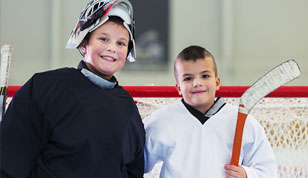Blog Categories
Search Blog
Blog Categories
Youth Sports Injuries: What to Look For
Essentially, there are two types of injuries that can occur in sports and recreational activities: a traumatic or sudden injury or an overuse injury. Both injuries can be serious and mean valuable time away from an athlete’s sport or your child’s favorite activity. When an injury is given timely medical management, proper rest and rehabilitation, the recovery time can be reduced.
Traumatic or sudden injuries can occur as a result of quick movements, change in directions, a fall, a collision or a hit from an opponent. Typical traumatic injuries include ligament tears, bone fractures, tendon tears, joint sprains, dislocations, and concussions. If an athlete or your child sustains a severe sudden or traumatic injury it usually requires immediate medical attention. Call 911 or take them to the nearest hospital. In the case of a suspected concussion, the player should not be permitted to return to the game or activity until they are medically cleared.
Overuse or repetitive strain injuries, on the other hand, are not so obvious. Often times these injuries occur gradually overtime due to repeated stress to one area of the body and lack of proper recovery time between training sessions. Immediately, the individual will experience minor pain and inflammation following activity. Overtime, however, if the individual continues to play through the pain and does not stop the aggravating movements, the tissues begin to break down and turn into a chronic injury. Examples include: patellofemoral syndrome affecting the knees in soccer players, stress fractures in the shins in runners, tendinitis of the elbow in tennis players, shoulder tendinitis in swimmers, and toe pain in dancers.
Here’s what to look for:
| Traumatic Injury | Overuse Injury |
|---|---|
|
|
|
|
|
|
|
|
|
|
Remember, the theory of “No Pain, no Gain” does not apply when a child or teen complains of pain. Their muscles and bones are growing and developing at a rapid rate and they are more vulnerable to injury. It is important to take care of injuries at the onset of pain, in order to prevent a chronic, long term problem that could potential affect them later in life.
In the case of an overuse injury, it is important to rest and decrease the intensity and frequency of games, practices and training. You can apply R.I.C.E (Rest, Ice, Compress, Elevate) to minor pain following activity for 10 minutes. If the pain persists, seek medical attention early. Book an appointment with your Family Doctor or physiotherapist in order to start medical intervention and prevent the onset of a chronic problem
Prevention: Traumatic and Overuse Injuries
- Wear the proper protective equipment. Ensure that all equipment fits properly and is inspected for tears, cracks and thinning of the material at the beginning of the season and on a regular basis
- Have an understanding of the symptoms of a concussion (www.parachute.org ) and ensure that individuals are assessed by a qualified individual following injury
- Ensure to perform proper warm-ups and cool downs prior to training and games
- Strengthening programs should be performed in the preseason as most injuries occur in the first 2-3 weeks of the season as a result of fatigue, poor endurance and poor muscle strength
- Ensure proper exercise techniques – seek advice from a qualified and trained athletic specialist
- Avoid over training – injuries mostly occur with doing too much too soon and rapid increases in training intensity
- Seek treatment from a medical professional early to achieve a faster recovery and ultimately a timely return to activity
References:
Consensus statement on concussion in sport: the 4th International Conference on Concussion in Sport held in Zurich, November 2012:
http://www.thinkfirst.ca/downloads/concussion/consensus-statement-2013.pdf
Helmet Safety:
https://www.aboutkidshealth.ca/article?contentid=1982&language=English
Injury Prevention:
http://www.parachutecanada.org/resources
Johnson, H. James (2008). Strength and Conditioning Journal. “Overuse Injuries in Young Athletes: Cause and Prevention”. Vol 30: 2: pg 27-31.
Soft Tissue Injuries:
https://www.aboutkidshealth.ca/article?contentid=931&language=English
Soligard T, Myflebust, G., Steffen, K., Silvers, H., Bizzini, M., Junge, A., Dvorak, J., Bahr, R., Andersen, T.E., (2008). British Medical Journal. Comprehensive warm-up programme to prevent injuries in young female footballers: cluster randomized controlled trial.
Stodden, D., Brooks, T. (2013). Strength and Conditioning Journal. Promoting Musculoskeletal Fitness in Youth: Performance and Health Implications from a Developmental Perspective. Vol 35: 3: Pg 54-62.






